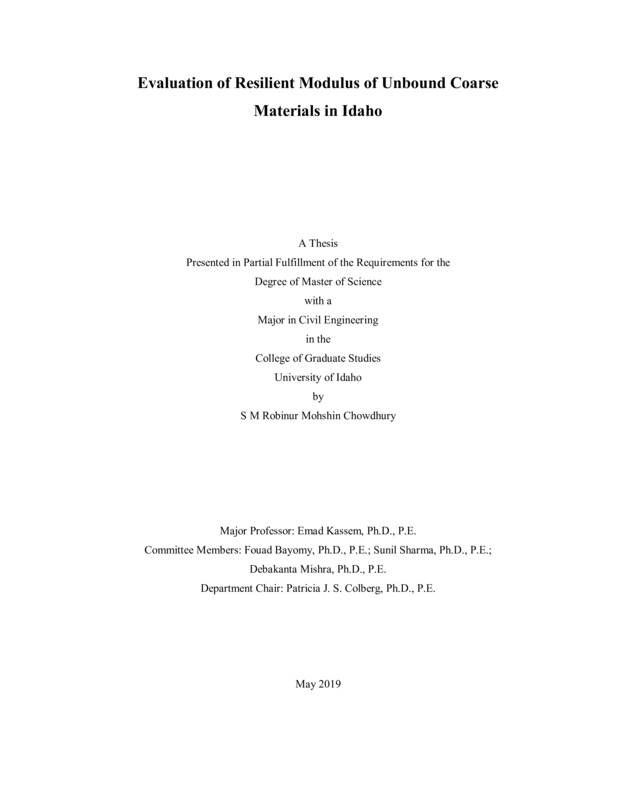Evaluation of Resilient Modulus of Unbound Coarse Materials in Idaho
Chowdhury, S M Robinur Mohshin. (2019-05). Evaluation of Resilient Modulus of Unbound Coarse Materials in Idaho. Theses and Dissertations Collection, University of Idaho Library Digital Collections. https://www.lib.uidaho.edu/digital/etd/items/chowdhury_idaho_0089n_11630.html
- Title:
- Evaluation of Resilient Modulus of Unbound Coarse Materials in Idaho
- Author:
- Chowdhury, S M Robinur Mohshin
- ORCID:
- https://orcid.org/0000-0001-8417-1832
- Date:
- 2019-05
- Embargo Remove Date:
- 2021-07-10
- Keywords:
- correlation internal LVDT prediction model resilient modulus unbound aggregates
- Program:
- Civil Engineering
- Subject Category:
- Civil engineering
- Abstract:
-
Several transportation agencies are moving towards implementation of the mechanistic-empirical (ME) approach to design and analyze pavement structures. The pavement ME design requires accurate characterization of material properties. The resilient modulus is a primary required input parameter for granular base and subbase layers. This study generated a database for typical unbound materials used in Idaho. Eighteen base and subbase materials were collected from all six districts of Idaho. Preliminary characterization tests (e.g., particle size distribution, Atterberg limits test, soil classification, moisture-density relationships) were carried out to obtain the inherent material properties. In addition, the resilient modulus test was conducted in accordance with AASHTO T 307. In this study, the resilient modulus was calculated using both external Linear Variable Differential Transducers (LVDTs) as well as internal LVDTs. Since the resilient modulus test is time consuming and required trained personnel, in addition the related equipment may not readily available to all transportation agencies, the author assessed the development of predictive models of the resilient modulus as a function of materials properties that are easier to measure. Furthermore, California bearing ratio (CBR) and light weight deflectometer (LWD) tests were conducted on the test materials to explore possible correlations with the resilient modulus. Both CBR and LWD are simpler tests to perform compared to the resilient modulus test.
The results of this study demonstrated that the internally-measured resilient modulus was found to be about 24% higher than the externally-measured resilient modulus. The external deformation was higher than the internal deformation due to the end plate and friction effects. The prediction models for the resilient modulus provided good correlations with the measured values. The proposed models can assist transportation agencies to accurately estimate the resilient modulus values for base and subbase materials from basic properties that are easy to measure.
The CBR test results showed a fair correlation with the resilient modulus while LWD showed a better correlation with the resilient modulus. Although, these correlations can be used to estimate the resilient modulus, the prediction model of the resilient modulus is recommended over these correlations. The prediction model provides estimates for the resilient modulus at all stress states provided in the AASHTO standard.
- Description:
- masters, M.S., Civil Engineering -- University of Idaho - College of Graduate Studies, 2019-05
- Major Professor:
- Kassem, Emad
- Committee:
- Bayomy, Fouad; Sharma, Sunil; Mishra, Debakanta
- Defense Date:
- 2019-05
- Identifier:
- Chowdhury_idaho_0089N_11630
- Type:
- Text
- Format Original:
- Format:
- application/pdf
- Rights:
- In Copyright - Educational Use Permitted. For more information, please contact University of Idaho Library Special Collections and Archives Department at libspec@uidaho.edu.
- Standardized Rights:
- http://rightsstatements.org/vocab/InC-EDU/1.0/

